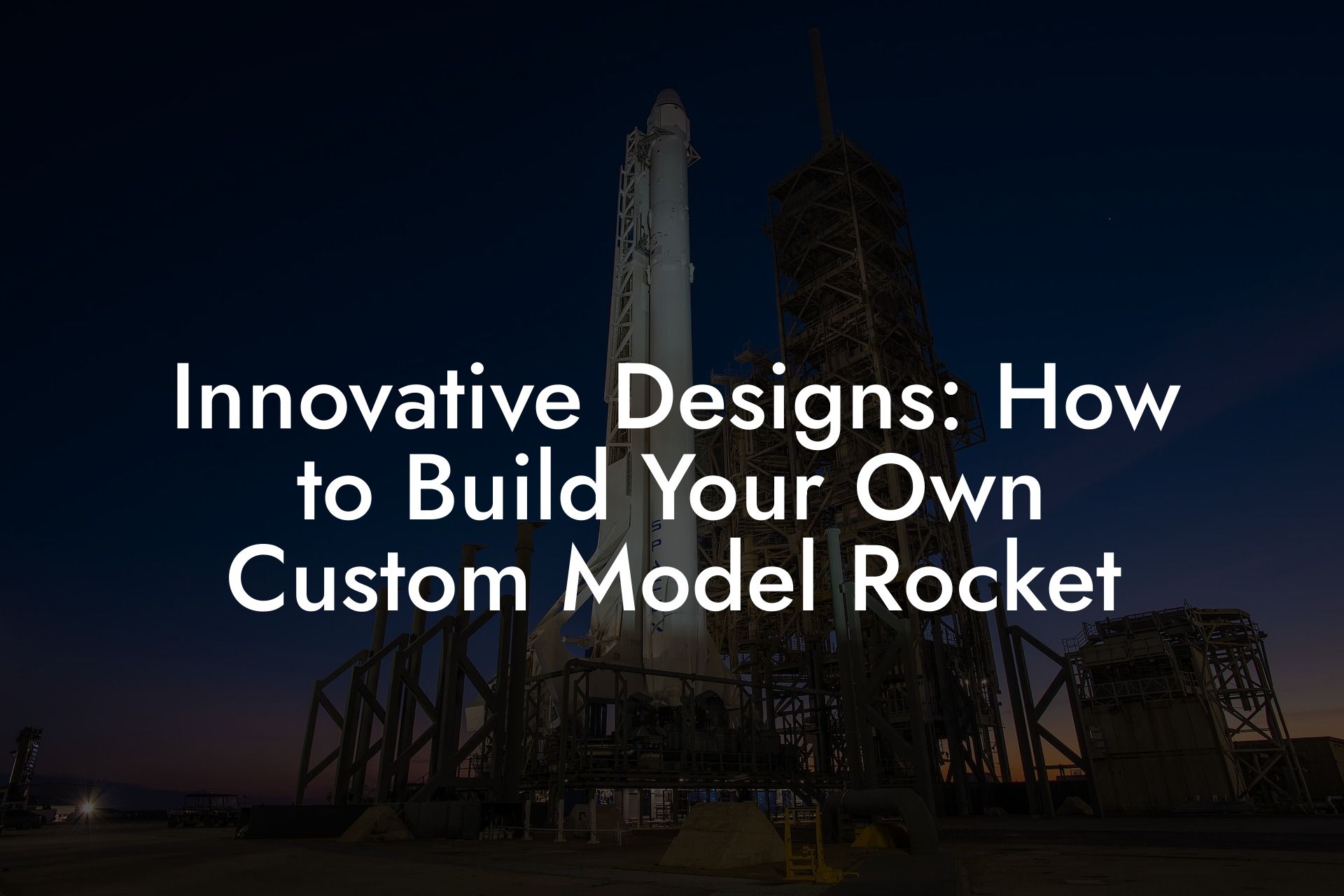Ready to push the boundaries of conventional model rocketry? Welcome to "Innovative Designs: How to Build Your Own Custom Model Rocket", your ultimate guide to creating a one-of-a-kind rocket that not only defies gravity but also redefines the art of DIY aerospace. Whether you’re an experiment-hungry beginner or a seasoned rocketeer looking to break the mold, this guide will walk you through the creative process, from innovative design concepts to advanced building techniques and custom finishes. Prepare to ignite your imagination and launch your ideas into the stratosphere!
Quick Links to Useful Sections
- The Vision Behind Custom Rocketry
- Getting Started: Gathering Inspiration and Tools
- Inspiration Sources
- Essential Tools and Materials
- Designing Your Custom Rocket: From Concept to Blueprint
- Material Selection: Balancing Durability, Weight, and Aesthetics
- Structural Materials
- Adhesives and Fasteners
- Finishing Materials
- Innovative Building Techniques: Bringing Your Design to Life
- Precision Cutting and Shaping
- Modular Assembly
- Incorporating Technology
- Advanced Adhesion Techniques
- Customizing Your Rocket: The Art of Personalization
- Creative Finishing Touches
- Lighting and Interactive Elements
- Structural Customization
- Testing, Iteration, and Optimization
- Pre-Launch Testing
- Flight Trials and Data Collection
- Iterative Improvements
- Safety Considerations for Custom Designs
- Structural Integrity
- Recovery System Reliability
- Electronic and Fuel Safety
- Engaging the Community: Sharing and Learning Together
- Online Forums and Social Media
- Workshops and Meetups
- Competitions and Exhibitions
- Model Rocketry FAQs: Your Custom Design Questions Answered
- Your Next Launch: Embrace Innovation and Custom Creativity
The Vision Behind Custom Rocketry
In the world of model rocketry, standard kits are just the beginning. Innovative designs allow you to create a rocket that’s truly your own, a rocket that reflects your unique style, ingenuity, and passion for flight. This guide is all about embracing the creative process, thinking outside the box, and transforming raw ideas into a high-flying, custom-built masterpiece.
Custom model rockets aren’t merely assembled; they’re designed, engineered, and personalized. Whether you’re dreaming of a rocket with LED lighting effects, aerodynamic curves that slice through the air, or even modular components that let you tweak your design between launches, this guide covers it all. Get ready to blend science with art and engineering with innovation.
Getting Started: Gathering Inspiration and Tools
Every great design starts with a spark of inspiration. Dive into a world of creative possibilities by exploring online galleries, rocketry forums, and maker spaces. From futuristic designs inspired by science fiction to sleek, minimalist rockets that focus on performance, the possibilities are endless.
Inspiration Sources
Check out design blogs, Instagram pages dedicated to DIY rocketry, and even aerospace magazines. Take note of color schemes, unique shapes, and innovative features that catch your eye. Create a mood board, either physically or digitally, to collect your favorite ideas and trends.
Looking For The Best Model Rocket Kits? You'll Love These:
Essential Tools and Materials
Custom rocketry requires more than just a kit; you’ll need quality tools and materials that let you bring your vision to life. Here’s a quick checklist:
- Design Software: CAD programs like Fusion 360, SketchUp, or even free alternatives like Tinkercad help you model your rocket in 3D.
- Cutting and Shaping Tools: Utility knives, precision craft knives, and a good pair of scissors for trimming materials to size.
- Measuring Instruments: Rulers, calipers, and flexible measuring tapes are essential for ensuring precision.
- Adhesives and Fasteners: Epoxy resin, white glue, hot glue guns, and even small screws for securing components.
- Finishing Supplies: Sandpaper, paint (acrylic or spray paints), decals, and special coatings to give your rocket a professional look.
With inspiration in one hand and the right tools in the other, you’re ready to embark on your custom rocketry journey.
Designing Your Custom Rocket: From Concept to Blueprint
The design phase is where your creative ideas start to take shape. Begin by sketching out your concepts on paper. Don’t worry about perfection at this stage, let your ideas flow freely. Consider the following elements:
- Purpose: What do you want your rocket to achieve? Is it all about aesthetics, or do you plan on breaking records for altitude or flight duration?
- Form and Function: Balance the artistic elements with aerodynamic principles. Think about how each curve, angle, and component will affect flight stability and performance.
- Modularity: Consider designs that allow for future modifications. A modular rocket design lets you swap out fins, adjust payload compartments, or even upgrade the engine mount as your skills grow.
Once you have your sketches, take the next step and create a digital blueprint using CAD software. This not only helps in visualizing your design in 3D but also allows you to run simulations to predict aerodynamic performance and structural integrity.
Digital design tools can reveal potential issues before you start cutting and gluing. Experiment with different shapes, test various materials in your simulation, and fine-tune your design until you’re confident that your rocket will perform as expected.
Material Selection: Balancing Durability, Weight, and Aesthetics
The materials you choose play a crucial role in the performance and appearance of your custom model rocket. Striking the right balance between durability, weight, and visual appeal is key.
Structural Materials
Your rocket’s body is its backbone. Consider these popular options:
- Balsa Wood: Perfect for those who want a lightweight, easy-to-shape material. It’s great for intricate designs and can be easily sanded to smooth out edges.
- Plastic and Fiberglass: These materials offer improved durability and are ideal for rockets that need to withstand multiple launches.
- Carbon Fiber: For advanced builders, carbon fiber provides exceptional strength-to-weight ratios and a sleek, high-tech look.
Adhesives and Fasteners
The glue that binds your rocket is as important as the materials themselves. Use high-quality adhesives like epoxy resin for a strong bond, especially when working with fiberglass or carbon fiber. For lighter materials, white glue or PVA works just fine.
Finishing Materials
Customization doesn’t stop at the design. Finishing touches such as premium paints, decals, and special coatings enhance the overall look and performance of your rocket. Consider:
- Airbrush Paints: Achieve a smooth, even finish with airbrush techniques that give your rocket a professional look.
- Decals and Vinyl Wraps: Personalize your rocket with custom graphics, logos, or patterns.
- Protective Coatings: Weather-resistant finishes that protect against moisture and UV damage, ensuring your rocket looks great launch after launch.
Thoughtful material selection is the foundation of both performance and aesthetics. Every component you choose has a direct impact on how your rocket flies and how it looks on the launch pad.
Innovative Building Techniques: Bringing Your Design to Life
With your blueprint and materials in hand, it’s time to start the build. Innovative techniques can streamline the process and add unique touches to your custom model rocket.
Precision Cutting and Shaping
Use precision tools like utility knives, laser cutters (if available), and calipers to cut your materials with exact accuracy. Clean, precise cuts are crucial for ensuring that all parts fit together seamlessly.
If you’re working with wood or composites, sanding and shaping are essential steps to achieve smooth, aerodynamic surfaces. Take your time to refine every curve and edge.
Modular Assembly
Consider designing your rocket in modules. A modular assembly allows you to build, test, and modify individual sections (like the engine bay or fin assembly) before integrating them into the final product. This approach not only simplifies troubleshooting but also opens up endless possibilities for upgrades and customization.
Incorporating Technology
For the tech-savvy builder, integrating elements like onboard cameras, telemetry sensors, or even microcontrollers can add a new dimension to your custom rocket. Imagine tracking real-time flight data or capturing stunning aerial footage during liftoff. These innovations require careful planning and additional components, but the results are truly out of this world.
Advanced Adhesion Techniques
Experiment with different bonding methods to ensure a strong, lasting connection between parts. Techniques such as clamping components while the adhesive cures or using a combination of fast-drying and high-strength adhesives can make all the difference in achieving a robust build.
The more innovative your building techniques, the more your custom rocket will stand out, not just in looks but in performance and reliability.
Customizing Your Rocket: The Art of Personalization
Customization is where you turn a functional rocket into a personal masterpiece. This is your chance to infuse your design with personality and flair.
Creative Finishing Touches
Start with a base coat of high-quality paint that complements your design. Experiment with gradients, metallic finishes, or even camo patterns to give your rocket a distinctive look.
Adding decals, vinyl wraps, or even hand-painted details can elevate your rocket from standard to show-stopping. Consider themes that resonate with you, be it futuristic, retro, or something entirely avant-garde.
Lighting and Interactive Elements
For an extra edge, incorporate LED lighting or glow-in-the-dark accents. These enhancements not only look spectacular during twilight launches but also add a modern, interactive dimension to your design.
Structural Customization
Beyond surface-level modifications, delve into structural customizations that improve performance. Adjust the shape of your fins, experiment with different nose cone profiles, or design a modular payload bay that allows you to swap out accessories for various missions.
Every customization should balance aesthetics with functionality. A beautiful design is only as good as its performance in the air.
Testing, Iteration, and Optimization
The journey to the perfect custom model rocket doesn’t end once it’s built. Testing and iteration are critical to refining your design and ensuring optimal performance.
Pre-Launch Testing
Before your first full-scale launch, perform a series of ground tests. Check the integrity of your joints, verify the deployment of your recovery system, and test any electronic components. These tests help identify issues that can be addressed before the real launch.
Flight Trials and Data Collection
Launch your rocket in a controlled environment and carefully document its performance. Use video recordings, telemetry data, and personal observations to note any anomalies or areas for improvement.
Iterative Improvements
Analyze your test data and make targeted modifications. This might involve adjusting the fin angle, redistributing weight, or even reconfiguring your recovery system. Each flight is a learning experience, every tweak brings you closer to perfection.
Embrace the iterative process. The road to a flawless custom rocket is paved with experiments, lessons learned, and continual refinements.
Safety Considerations for Custom Designs
Safety is paramount in every aspect of model rocketry, especially when venturing into custom designs. Innovative projects often involve untested configurations, so a rigorous approach to safety is essential.
Structural Integrity
Ensure that every custom modification maintains or enhances the structural integrity of your rocket. Reinforce joints where necessary and perform stress tests to verify that your modifications can handle the forces of launch and flight.
Recovery System Reliability
A custom design should never compromise the recovery system. Test your parachute or streamer multiple times, and make sure that any changes to the body or weight distribution do not interfere with a smooth descent.
Electronic and Fuel Safety
If you’re incorporating electronic components like telemetry or onboard cameras, ensure that all wiring is secure and insulated. When experimenting with different engines or fuel types, always follow manufacturer guidelines and local regulations to prevent accidents.
By prioritizing safety at every stage, you can experiment boldly while keeping yourself and your community secure.
Engaging the Community: Sharing and Learning Together
One of the greatest joys of custom rocketry is the sense of community it fosters. Sharing your innovative designs not only inspires others but also opens the door to valuable feedback and collaborative improvement.
Online Forums and Social Media
Post your designs, photos, and videos on platforms like Reddit, Instagram, and dedicated rocketry forums. Engaging with a community of fellow enthusiasts can spark new ideas and help troubleshoot challenging problems.
Workshops and Meetups
Attend local rocketry clubs, maker spaces, and workshops. These events offer hands-on opportunities to learn from experts, test your custom designs in real-world settings, and share your journey with like-minded individuals.
Competitions and Exhibitions
Consider entering your custom rocket in competitions or exhibitions. These events not only provide a platform to showcase your work but also motivate you to push the boundaries of innovation and performance.
The feedback and camaraderie you experience in the rocketry community are invaluable resources on your journey to building the perfect custom model rocket.
Model Rocketry FAQs: Your Custom Design Questions Answered
Below are some frequently asked questions that address common challenges and curiosities about building your own custom model rocket.
1. What makes a custom model rocket different from a kit?
A custom model rocket is designed and built with your unique specifications in mind. While kits provide a standard set of components, custom designs allow for personalized modifications in aesthetics, performance, and functionality.
2. How do I start designing my own custom rocket?
Begin with brainstorming and sketching your ideas. Use CAD software to create a digital blueprint and run simulations to refine your design before you start building.
3. What materials are best for custom builds?
Popular choices include balsa wood for ease of shaping, plastic and fiberglass for durability, and carbon fiber for high-performance, lightweight builds. The best material depends on your design goals and skill level.
4. Can I modify a standard kit to create a custom rocket?
Absolutely! Many enthusiasts start with a kit and then add their own custom modifications, from unique paint jobs to structural adjustments, to create a rocket that’s uniquely theirs.
5. How do I ensure my custom design is aerodynamically efficient?
Use simulation tools to analyze aerodynamic performance and carefully measure the center of gravity. Iterative testing and adjustments based on flight data are essential to maintaining efficiency.
6. What advanced tools can help refine my custom design?
CAD software, digital calipers, and simulation programs are invaluable. They help you visualize your design, perform precision measurements, and predict how modifications will affect flight performance.
7. How important is safety in custom rocketry?
Safety is paramount. Always ensure that structural modifications do not compromise integrity, test your recovery systems thoroughly, and follow best practices for handling fuel and electronics.
8. Where can I get feedback on my custom designs?
Online forums, social media groups, local rocketry clubs, and maker spaces are excellent places to share your designs and receive constructive feedback from experienced enthusiasts.
9. How can I document my custom design process?
Keeping a build journal with sketches, CAD models, photos, and flight data is a great way to track your progress, troubleshoot issues, and share your journey with others.
10. What are the latest trends in custom model rocketry?
Innovations include the use of advanced composites, integration of smart technology like onboard sensors and cameras, modular designs for easy upgrades, and sustainable materials that reduce environmental impact.
Your Next Launch: Embrace Innovation and Custom Creativity
Building your own custom model rocket is more than a project, it’s a journey of creativity, technical exploration, and personal expression. Every innovative design, every custom detail, and every successful launch propels you further into the exciting world of DIY aerospace.
Whether you’re sharing your journey online, entering competitions, or simply enjoying the thrill of a perfectly executed liftoff, remember that your custom rocket is a testament to your ingenuity and passion. The sky is not the limit; it’s just the beginning.
So, gather your tools, unleash your creativity, and prepare to build a custom model rocket that stands as a unique reflection of who you are. Innovation awaits, let your ideas soar!
Looking For The Best Model Rocket Kits? You'll Love These:
Useful Interruption: Dive deeper into the world of Model Rockets with our most popular sections. If there is anything you think is missing or anything you would love for us to write about, just give us a shout.
- Getting Started & Basics With Model Rockets
- Model Rocket Design, Build & Customization
- Model Rocket Propulsion & Engine Technology
- Model Rocket Launch Techniques & Recovery
- Model Rocket Advanced Rocketry & Innovations
- Model Rocket DIY and Customization
- Model Rocket Equipment Reviews & Digital Tools
- Community, Competitions & Education
- Model Rocket Troubleshooting & FAQs
- Model Rocket Bonus/Seasonal & Niche Topics
A group of model rocket enthusiasts gathered at a field for their weekly launch event. Among them was Dave, a seasoned builder known for pushing the limits of hobby rocketry. This time, he had outdone himself.
“Ladies and gentlemen,” Dave announced, dramatically pulling a cloth off his latest creation, “I present to you: The Kraken!”
The crowd gasped. This wasn’t just a model rocket, it was a monster. The thing stood 8 feet tall, had six clustered engines, and was covered in enough duct tape to qualify as a classified aerospace project.
“Dave,” muttered Steve, the cautious safety officer, “Have you, uh… done the math on this?”
“Math?” Dave scoffed. “I built it in my garage at 3 a.m. with parts from eBay. This is an art piece, Steve.”
The countdown began.
5…
4…
3…
2…
1…
The engines ignited with a BOOM, and The Kraken shot up… kind of. It immediately did a violent barrel roll, narrowly missing the spectators before skyrocketing at an angle that could only be described as “legally questionable.”
The crowd collectively ducked as The Kraken flew straight over the adjacent cornfield, where Old Man Jenkins, the grumpiest farmer in town, was minding his business.
KABOOM!
The rocket disappeared behind the barn. A moment later, a flaming piece of Estes igniter wire landed at Steve’s feet. The silence was deafening.
And then, an unmistakable sound echoed across the field.
Jenkins’ shotgun being cocked.
“DAVE!!!” Steve shouted. “RUN.”
And that was the day Dave invented the first-ever biologically powered rocket booster: pure adrenaline.
To this day, nobody knows where The Kraken landed, but legend has it, it still haunts the skies, terrifying unsuspecting drones and low-flying birds.






